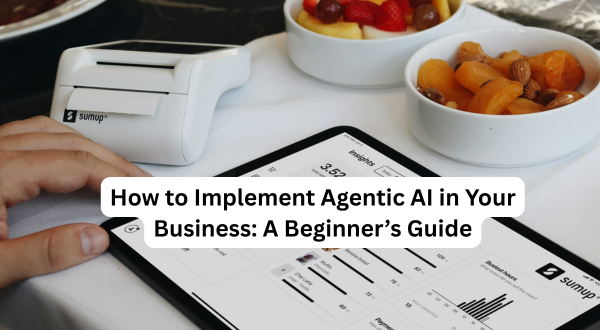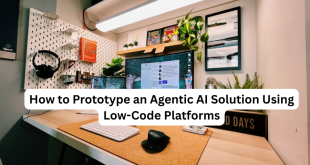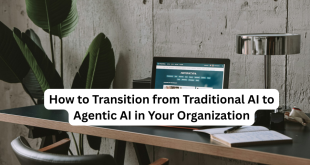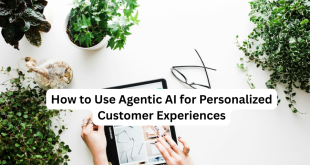In the rapidly evolving world of technology, Agentic AI is emerging as a game-changer for businesses. Unlike traditional AI, which often requires human input to function, Agentic AI systems operate autonomously, making decisions and executing tasks with minimal oversight. From optimizing supply chains to personalizing customer experiences, these intelligent agents are transforming industries. But how can your business harness this cutting-edge technology? In this beginner’s guide, we’ll walk you through the essentials of implementing Agentic AI, covering tools, platforms, and key considerations to ensure success.
What is Agentic AI?
Agentic AI refers to AI systems capable of independent decision-making and action-taking to achieve specific goals. Think of it as a virtual employee that can analyze data, adapt to changing conditions, and execute tasks without constant supervision. For example, an Agentic AI in retail might monitor inventory, predict demand, and reorder stock autonomously, saving time and reducing errors.
The potential is vast, but implementing Agentic AI requires careful planning. Here’s a step-by-step guide to get started.
Step 1: Identify Business Needs and Use Cases
Before diving into Agentic AI, pinpoint where it can add the most value. Ask yourself:
- What repetitive or complex tasks could be automated?
- Where do delays or inefficiencies occur in your workflows?
- Are there opportunities to enhance customer experiences through real-time decisions?
Common use cases include:
- Supply Chain Management: AI agents monitor stock levels, predict shortages, and optimize logistics.
- Customer Service: Autonomous chatbots resolve queries and escalate only when necessary.
- Marketing: AI personalizes campaigns by analyzing customer behavior in real time.
- Finance: Agents detect fraud or automate compliance tasks.
For instance, a small e-commerce business might use Agentic AI to streamline order fulfillment, while a healthcare provider could deploy it to triage patient inquiries. Start with a single, high-impact use case to test the waters.
Step 2: Choose the Right Tools and Platforms
Implementing Agentic AI doesn’t mean building everything from scratch. A growing ecosystem of tools and platforms makes adoption accessible, even for businesses without deep technical expertise. Here are some options to consider:
- Pre-Built AI Platforms:
- Google Cloud AI: Offers tools like Vertex AI for building and deploying AI agents with decision-making capabilities.
- Microsoft Azure AI: Provides frameworks for creating autonomous agents integrated with enterprise systems.
- IBM Watson: Specializes in AI agents for industries like healthcare and finance.
- Open-Source Frameworks:
- LangChain: A popular framework for building AI agents that interact with external data and tools.
- AutoGen: Enables multi-agent systems where AI agents collaborate to solve complex tasks.
- Hugging Face: Offers pre-trained models that can be fine-tuned for specific agentic tasks.
- Low-Code/No-Code Solutions:
- Platforms like UiPath or Zapier (with AI integrations) allow businesses to create simple AI agents without coding expertise.
For beginners, low-code platforms or pre-built solutions are ideal, as they reduce development time and complexity. If your business has in-house developers, open-source frameworks offer greater customization.
Step 3: Gather and Prepare Data
Agentic AI thrives on data. To make informed decisions, AI agents need access to high-quality, relevant data. Here’s how to prepare:
- Centralize Data: Integrate data from CRM systems, ERP software, or IoT devices into a single repository (e.g., a cloud-based data lake).
- Clean Data: Remove duplicates, correct errors, and standardize formats to ensure accuracy.
- Ensure Real-Time Access: Agentic AI often requires live data feeds to act dynamically, such as monitoring website traffic or inventory levels.
For example, a retail business implementing an AI agent for inventory management would need real-time data on sales, stock levels, and supplier lead times. Invest in data infrastructure early to avoid bottlenecks later.
Step 4: Design and Train Your AI Agent
Once you’ve selected a platform and prepared your data, it’s time to design your AI agent. Key steps include:
- Define Goals: Specify what the agent should achieve (e.g., “reduce stockouts by 20%” or “respond to 80% of customer queries without human intervention”).
- Set Boundaries: Establish limits to prevent unintended actions, such as spending caps for automated purchasing agents.
- Train the Model: Use historical data to train the AI, fine-tuning it to your business context. Many platforms offer pre-trained models that require minimal tweaking.
- Test Extensively: Run simulations to ensure the agent makes accurate decisions in various scenarios.
For instance, a marketing AI agent could be trained on past campaign data to optimize ad spend autonomously. Testing ensures it doesn’t overspend or target the wrong audience.
Step 5: Deploy and Monitor
With your AI agent ready, deploy it in a controlled environment. Start with a pilot project to minimize risks. For example, test an AI customer service agent on a subset of inquiries before rolling it out fully.
Monitoring is critical:
- Track performance metrics (e.g., task completion rate, error rate, or cost savings).
- Collect user feedback to identify pain points.
- Use observability tools to monitor decisions and ensure transparency.
Agentic AI systems learn over time, so continuous monitoring allows you to refine their behavior. Platforms like Google Cloud AI and Azure provide dashboards for real-time performance tracking.
Step 6: Address Ethical and Security Considerations
Agentic AI’s autonomy raises unique challenges. To implement it responsibly:
- Ensure Transparency: Make it clear when customers are interacting with an AI agent, especially in sensitive areas like healthcare or finance.
- Mitigate Bias: Regularly audit AI decisions to prevent biases in data or algorithms from affecting outcomes.
- Secure Data: Use encryption and access controls to protect sensitive data the AI processes.
- Maintain Human Oversight: Design kill switches or manual overrides for critical decisions.
For example, a financial AI agent approving loans should be audited to ensure it doesn’t discriminate based on biased historical data. Compliance with regulations like GDPR or CCPA is also essential.
Step 7: Scale and Optimize
Once your pilot succeeds, scale Agentic AI to other areas of your business. Use insights from the initial deployment to optimize performance:
- Integrate with more systems (e.g., connect a customer service AI to your CRM).
- Expand use cases (e.g., add predictive analytics to an inventory AI).
- Invest in employee training to ensure staff can work alongside AI agents effectively.
Scaling gradually helps manage costs and complexity while maximizing ROI. According to Gartner, businesses adopting autonomous AI could see productivity gains of up to 30% by 2028.
Challenges to Anticipate
While Agentic AI offers immense potential, beginners should be aware of common hurdles:
- High Initial Costs: Data infrastructure and platform subscriptions can be expensive, though cloud-based solutions reduce upfront investments.
- Skill Gaps: You may need to hire or train staff with AI expertise or partner with vendors.
- Resistance to Change: Employees may fear job displacement, so communicate how AI enhances, not replaces, their roles.
Proactive planning—such as starting small and involving employees early—can mitigate these challenges.
Tools to Get Started
To kickstart your Agentic AI journey, consider these beginner-friendly tools:
- Zapier + AI Integrations: Automate workflows with AI-driven triggers (no coding required).
- Google Dialogflow: Build conversational AI agents for customer service.
- LangChain: Create custom AI agents with open-source flexibility.
- UiPath: Design AI-powered robotic process automation for business tasks.
Many of these offer free tiers or trials, making them accessible for small businesses.
The Future of Agentic AI in Business
Agentic AI is no longer a futuristic concept—it’s here, and businesses of all sizes can leverage it to stay competitive. By starting with a clear use case, choosing the right tools, and addressing ethical considerations, you can implement AI agents that drive efficiency, innovation, and growth. As the technology evolves, early adopters will gain a significant edge, positioning themselves as leaders in the AI-driven economy.
Ready to take the plunge? Identify one process in your business that could benefit from autonomy, explore a platform like Google Cloud AI or LangChain, and start small. The future of your business might just be a few autonomous decisions away.
 UBUCH ubuch | Honest Tech Reviews & Tutorials for Everyone
UBUCH ubuch | Honest Tech Reviews & Tutorials for Everyone




